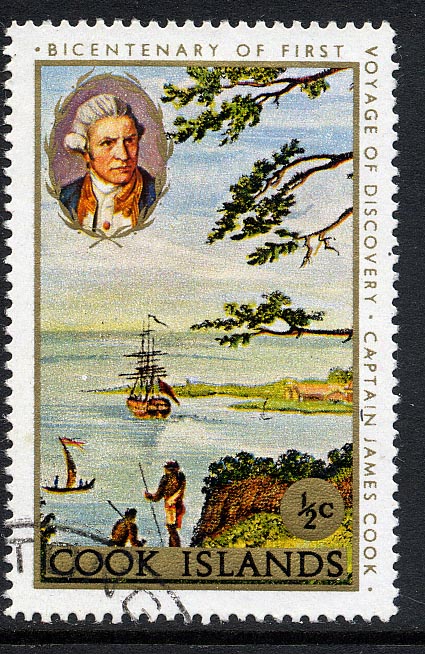
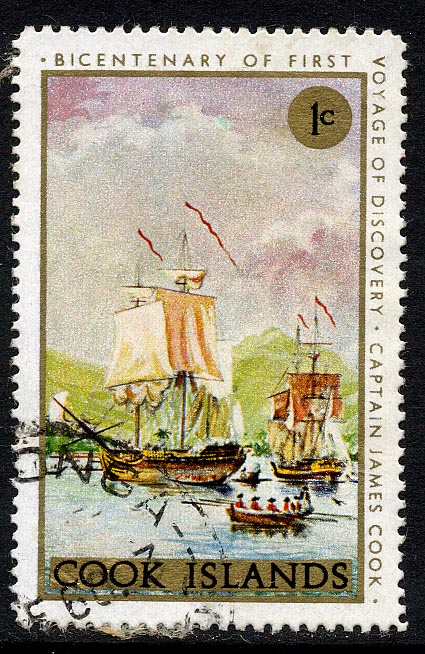
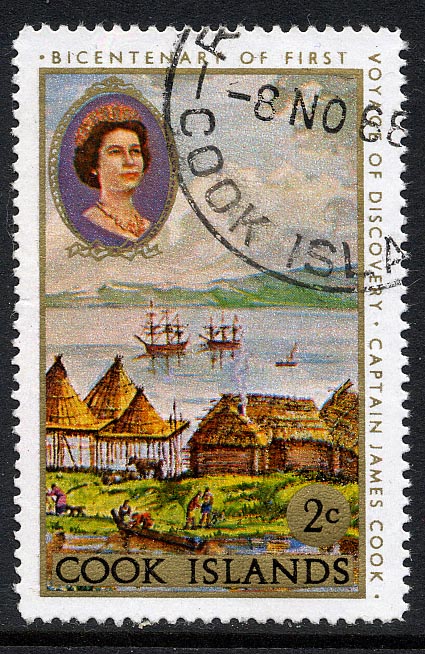
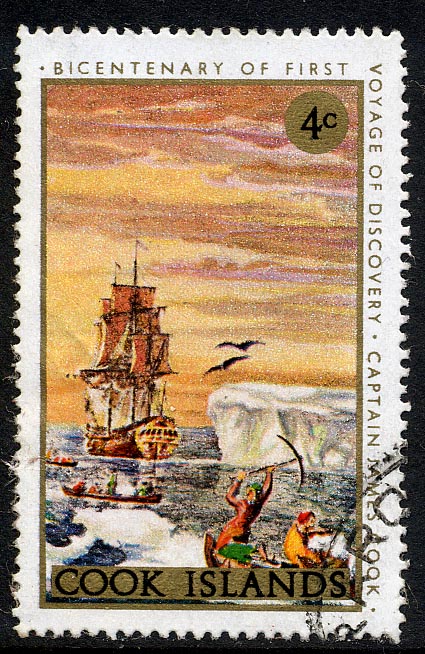
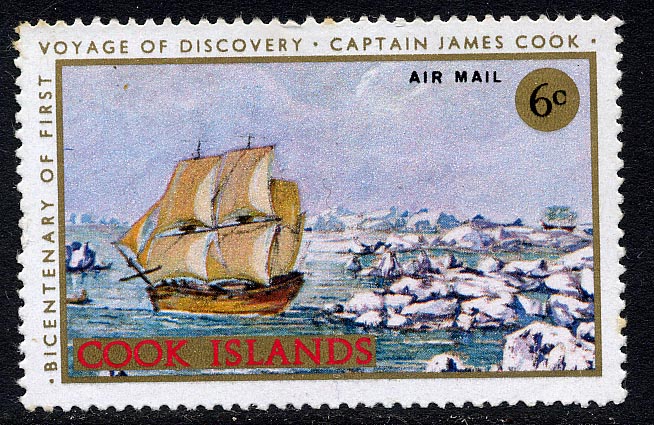
On September 12th 1968, the Cook Islands Post Office issued a set of eight stamps, each printed in five-colour photogravure, the designs all being actual reproductions of paintings, or drawings, made on the spot by the officially appointed artists for the three voyages that Captain Cook made to the Pacific, from authentic material in the collections of the Alexander Turnbull Library, Wellington, New Zealand.
The titles shown below are those of the original pictures. In some cases the modern names of the areas have been added in parentheses.
1/2c Matavai Bay, Otahiete (Tahiti), Cook's first Pacific landfall, from an engraving after a pen and wash drawing by Sydney Parkinson.
lc. View of the island of Huaheine, one of the Society Islands (Tahiti), from a water colour by John Cleveley based on a sketch from nature by his brother James Cleveley.
2c View of town and harbour of St. Peter and St. Paul, in Kamchatka, by J Webber.
4c The Ice Islands (Antarctica), seen on January 9, 1773, drawn from nature by W. Hodges.
6c. The Resolution beating through the ice, with the Discovery in most imminent danger in the distance, by John Webber.
10c The Island of Otahiete (Tahiti), after a painting by W. Hodges.
15c A view of Karakakooa on Owyhee (Hawaii), by J Webber.
25c. The Landing at Middleburg, one of the Friendly Islands (Tonga), painting by W. Hodges.
Full colour portraits, of H.M. The Queen, or Captain Cook, are included in some of the stamp designs.
It seems strange indeed that Captain Cook, one of the greatest sailors in history, never commanded a ship¬of-the-line. He was promoted to the rank of lieutenant to take charge of the Endeavour, which set sail from Plymouth for the South Pacific on August 26, 1768, to observe the transit of Venus. In Matavai Bay this transit was clearly observed, from the anchorage, seen on the lc. stamp. On this voyage were the landscape artist Alexander Buchan and the natural history draughtsman Sydney Parkinson. Buchan died a few days after reaching Tahiti and was buried at sea. Parkinson's sketch of Matavai Bay is quite a competent piece of work for a non-professional artist. Actually this is the only stamp in the series that depicts a scene from the first voyage of Cook, probably because the artist was a little unsure of his artistic ability.
On the second voyage the experienced painter William Hodges was engaged as the artist of the voyage. Hodges was a man of very considerable talents whose seascapes were to prove his ability to come to terms with the bright colours and light of the Pacific, The romantic views current in the period are seen in Hodges' work, as well as his classical training, but his realism is also evident in his drawings from nature, such as his scenes of the fragile ships among the huge threatening towers and pinnacles of the seemingly endless ice-packs through which they travelled. All these aspects are shown on the three stamps reproducing his work (4c. 10c & 25c.).
On the third voyage, the artist John Webber, the son of a famous Swiss sculptor, was employed to pictorially record the places and events to be seen for the first time by western man. His precise artistic records of the long third voyage beautifully represents the otherwise unknown part of the world, and some of the dangers of the voyage.
by Captain Cook on his exploration of the Pacific.
Details of the ships: The Endeavour, a barque of 368 tons, built at Whitby in 1764 as the collier Earl of Pembroke and owned by Mr. Thomas Milner. She was purchased by the Admiralty for £2,840 in 1768, and renamed. The vessel had a square stern, was bluff-bowed, stolid and undecorated, and was fitted out at Deptford, in 1768, for Cook. Her dimensions were: 97.8 x 29.2 x 11.4 ft. Complement 94. Her sides and lower masts were of varnish colouring, her yards blacked. She was sold out the Service in 1775 and returned to collier duties.
The Resolution, was built by Mr. Fisliburn of Whitby, (who also built the Endeavour), in 1770. The Admiralty bought her in 1771 from Captain W. Hammond, of Hull, and she entered the Navy as the Drake. Her name was altered to Resolution while she was refitting. Her dimensions were: Keel 93.5 ft., beam 301 ft., depth in hold 13 ft. burden 462 tons. She carried 12 swivel guns and 12 carriage guns. She was also used on Cook's third voyage. The Resolution was retained in the Navy after she returned to England from Cook's last voyage. On June 9, 1782, she was captured by the French corvette La Sylphide and taken in charge of a prize crew to the fleet of Admiral Suffren, then operating in the Indian Ocean against British forces under Admiral Hughes. Suffren sent her to Manila for supplies. Sir John Borrow saw her in Porto Prayar in 1792, under the revolutionary flag, posing as a whaler. Her final end is not known.
Accompanying the Resolution on the second voyage was the Adventure, 330 tons (Capt. Tobias Furneoux). The two ships put out from Plymouth Sound on July 13, 1772, to explore the Southern Hemisphere. On February 8, 1773, the ships were separated in fog while in the Antarctic and did not meet again until May 18, in Queen Charlotte's Sound. On October 30 the ships were finally separated, the Resolution carrying on alone. She arrived back in England over a year after the Adventure.
Fourth of Cook's ships was the Discovery (Capt. Charles Clerke), which was built at Whitby and was one year and six months old when first examined by Cook on January 4, 1776; five days later the Admiralty bought her on Cook's recommendation. Formerly the brig Diligence, she was valued at £1,685, a single-bottomed, full-built, very roomy ship. She was altered to ship rig and renamed N.M. sloop Discovery. Complement was 70 men. She was sheathed for the voyage and victualled for 12 months, but with only one month's beer supply. Lieut. Orsbridge's "machine for rendering stinking water sweet" to use the
Admiralty's delightful phrasing, was supplied. She was armed with eight guns. Her cost of alterations for Naval service was estimated at £550. The Discovery carried the frame of a 17-ton ship, to be fitted together as an emergency ship, if needed.
This multi-coloured stamp series commemorating the bicentenary of the departure of Cook on his explorations has been printed in small sheets of 10 stamps, each sheet bearing full colour portraits of Her Majesty Queen Elizabeth H, and Cook plus a commemorative inscription.
SG274-275 Sea Breezes 11/68
